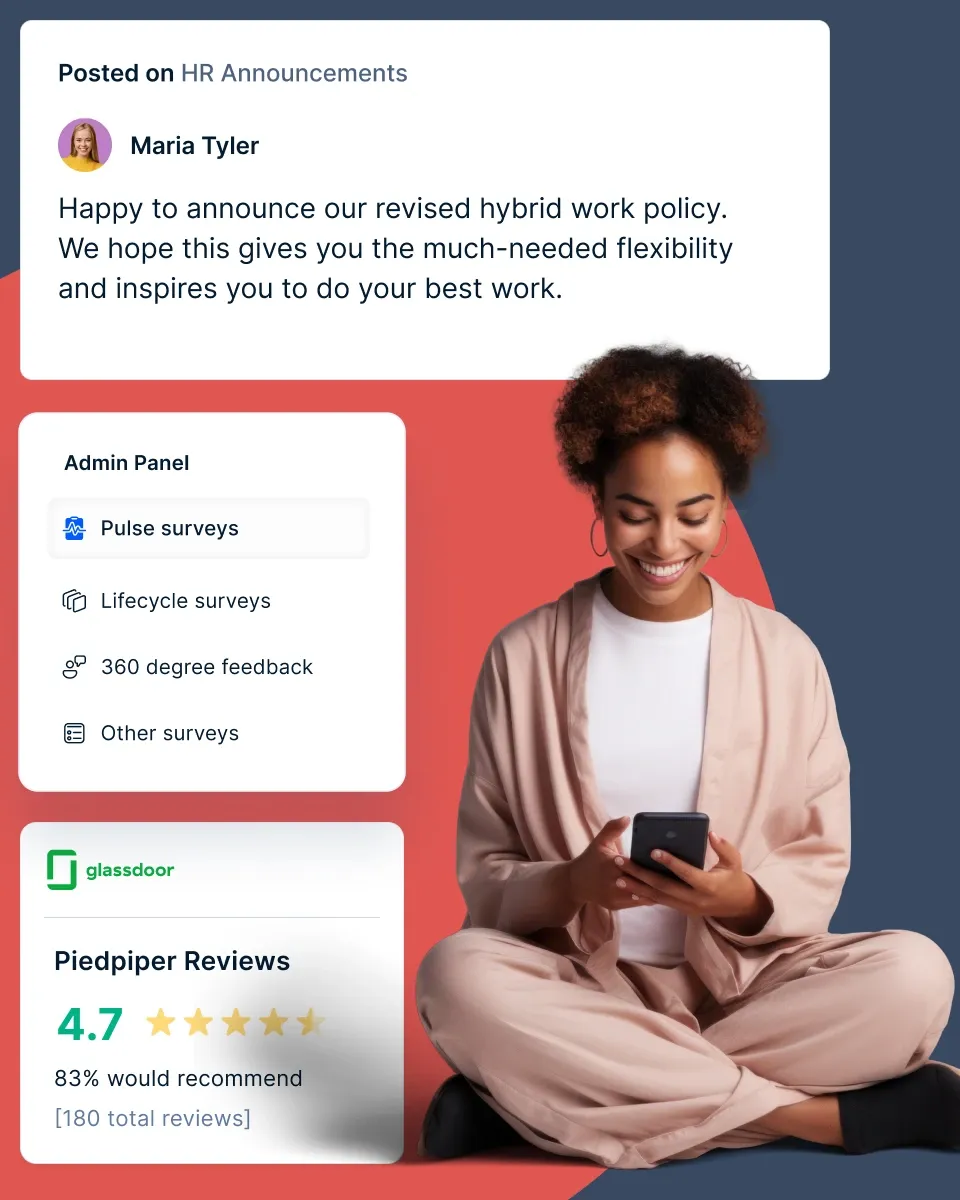How to Deal with Underperforming Employees: 5 Effective Ways
Dealing with underperforming employees often becomes tricky and leads to some awkward conversations. How do you manage an underperforming employee? Use this step-by-step guide to understand how to deal with underperforming employees and motivate them to stay on track.
On this page
- What is underperformance?
- 5 Major causes of employee underperformance
- How to deal with underperforming employees: A step-by-step guide
- Using Empuls to drive engagement and improve performance
- Recognition that inspires, not just rewards
- Uncover the real reasons behind underperformance
- Bringing teams closer with better communication
- Conclusion
Managing underperformance in the workplace is one of the biggest challenges for any leader. An underperforming employee can disrupt team dynamics, lower morale, and affect overall business performance. Ignoring the issue only allows it to escalate, creating a cycle of disengagement and frustration for both the employee and the organization.
However, effective leaders know that how to deal with underperforming employees is not just about addressing the symptoms but understanding the root causes.
Is the issue due to a lack of skills, unclear expectations, workplace stress, or disengagement?
A thoughtful approach that balances accountability with support can turn underperformance into an opportunity for growth.
In this guide, we’ll explore actionable strategies to help struggling employees improve, re-engage with their work, and contribute meaningfully to the organization’s success.
What is underperformance?
Underperformance in the workplace occurs when an employee's work quality falls below the required standards and expectations. While the severity and nature of underperformance may vary, certain behaviors often indicate an issue, such as:
- Not meeting job expectations or consistently failing to complete tasks properly
- Engaging in disruptive, harmful, or unprofessional behavior
- Ignoring or failing to comply with workplace rules, procedures, or policies
In practical terms, an underperforming employee may frequently miss deadlines, arrive late, show reduced enthusiasm for their role, or produce low-quality work. Addressing these issues early can prevent further impact on team productivity and overall workplace morale.
5 Major causes of employee underperformance
Employee underperformance can be attributed to various internal and external factors that can affect an individual's ability to meet job expectations.
Identifying the cause of underperformance is crucial for implementing effective strategies to address the issue.
Here are some common causes of employee underperformance:
1. Lack of clear expectations and goals
Employees perform best when they have a clear understanding of their responsibilities and objectives. Confusion sets in when expectations are vague or constantly shifting, leading to decreased motivation and productivity. Without well-defined goals, employees may struggle to prioritize tasks and deliver results.
2. Insufficient training and development
A lack of proper training leaves employees feeling unprepared for their roles. Without ongoing skill development, they may struggle to keep up with evolving job demands, leading to reduced efficiency and engagement.
3. Poor leadership and management
Ineffective managers who fail to provide guidance, constructive feedback, or recognition can lower employee morale. A lack of leadership support results in disengagement and decreased motivation to perform well.
4. High levels of stress and burnout
Excessive workloads, unrealistic deadlines, and poor work-life balance can cause burnout. When employees feel overwhelmed, their productivity declines, and they are more likely to make mistakes or disengage.
5. Toxic work environment and poor team dynamics
A workplace filled with conflicts, favoritism, or lack of trust can discourage employees from giving their best effort. Negative relationships with colleagues or managers contribute to disengagement and lower performance.
How to deal with underperforming employees: A step-by-step guide
Underperformance in the workplace can significantly impact team productivity, morale, and business outcomes. Here’s a step-by-step guide to managing an underperforming employee in a constructive and effective way.
1. Identify the root cause of underperformance
Before taking any action, determine why the employee is struggling. Underperformance can result from various factors, including:
- Lack of clarity in job expectations
- Insufficient training or resources
- Workplace stress or burnout
- Poor engagement or motivation
- Personal issues affecting work performance
Conduct a one-on-one conversation with the employee to understand their perspective. Anonymous employee surveys using tools like Empuls can also provide valuable insights into workplace challenges affecting multiple employees.
2. Set clear expectations and provide constructive feedback
Employees may underperform if they are unsure about expectations or lack guidance. Clearly define job responsibilities, performance standards, and key deliverables. When providing constructive feedback, focus on specific examples rather than general statements.
Example: Instead of saying, "Your work quality needs improvement," say, "The last report contained multiple errors, which delayed the client submission. Let’s work together to ensure accuracy moving forward."
Regular formal and informal feedback sessions help employees stay aligned with expectations and track their progress over time.
3. Create an improvement plan
Once the root cause is identified and feedback has been given, establish a performance improvement plan (PIP) outlining clear, achievable goals. This plan should include:
- Specific areas of improvement
- Measurable performance metrics
- A realistic timeline for improvement
- Support and resources needed for success
For instance, the improvement plan could involve time management training and weekly progress check-ins if an employee struggles with meeting deadlines. Empuls' rewards and recognition features can also motivate employees by acknowledging small improvements along the way.
4. Provide training and support
Underperformance often stems from skill gaps or lack of proper training. Offering relevant training programs, mentorship, or peer support can bridge these gaps. If employees lack confidence in their role, providing on-the-job coaching or pairing them with an experienced team member can help.
Using a collaborative platform like Empuls can also enhance knowledge sharing and keep employees engaged through team discussions, recognition, and ongoing learning opportunities.
5. Monitor progress and provide ongoing feedback
Once an improvement plan is in place, track the employee’s progress through regular check-ins. These sessions should focus on:
- Reviewing performance improvements
- Identifying any remaining challenges
- Adjusting strategies as needed
If the employee is improving, recognize their efforts and encourage them to continue. If performance remains unchanged, explore whether further support is needed or if a different approach should be taken.
6. Address persistent underperformance
If an employee continues to struggle despite training, feedback, and support, it may be time for more formal action. This could involve:
- Reassignment to a more suitable role
- Additional training or coaching
- Formal warnings or disciplinary measures
When termination is the last resort, ensure the decision is fair, well-documented, and in line with company policies. However, the goal should always be to help employees succeed rather than replace them.
Using Empuls to drive engagement and improve performance
Addressing underperformance in the workplace isn’t just about corrective measures—it’s about creating an environment where employees feel valued, heard, and motivated to do their best work. This is where Empuls steps in, helping organizations go beyond performance reviews and build a culture that naturally encourages employees to improve.
Recognition that inspires, not just rewards

A disengaged workforce is often at the root of underperformance, and a lack of recognition only worsens it. Empuls' rewards and recognition platform helps organizations acknowledge achievements in real-time, reinforcing positive behaviors that contribute to productivity.
But it’s not just about bonuses and milestone awards—it’s about creating a culture where appreciation becomes second nature. When employees see their contributions being noticed, they are more likely to stay motivated and take ownership of their roles.
Uncover the real reasons behind underperformance

Low productivity, disengagement, or missed deadlines don’t happen in isolation. Organizations need to look beyond surface-level issues and understand why employees are struggling.
Empuls’ employee survey tool gives organizations deeper insights into workplace sentiment, helping uncover challenges like workload stress, unclear expectations, or gaps in leadership support. By giving employees a voice, companies can address problems before they escalate into long-term performance issues.
Bringing teams closer with better communication

Underperformance often thrives in disconnected workplaces where communication feels rigid, top-down, or non-existent. Empuls’ social intranet changes that by making conversations more fluid and collaborative.
Whether it’s sharing success stories, team updates, or simply breaking silos between departments, better workplace interactions naturally lead to more engaged employees—those who understand their roles, feel part of something bigger, and are more inclined to improve their performance.
Underperformance isn't just about individual employees—it’s about the work culture they operate in. Empuls helps organizations create an environment where employees feel appreciated, connected, and empowered, ultimately reducing disengagement and improving overall productivity
Conclusion
Performance is vital if you want your business to succeed. Employees performing below average over a long period will start to take their toll on your company and its bottom line, so it’s important to address performance issues as soon as they crop up.
To do this, you must hold regular feedback sessions and reviews for all staff members and provide a clear action plan when you identify any areas that need improvement.
Empuls is the All-In-One Solution for Employee Engagement. Improve employee productivity, performance & retention with an easy-to-use engagement application. Want to know more? Book a demo or start a free trial.


















